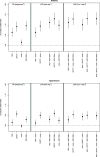Associations of Combined Exposures to Surrounding Green, Air Pollution, and Road Traffic Noise with Cardiometabolic Diseases
- PMID: 31393793
- PMCID: PMC6792364
- DOI: 10.1289/EHP3857
Associations of Combined Exposures to Surrounding Green, Air Pollution, and Road Traffic Noise with Cardiometabolic Diseases
Erratum in
-
Erratum: "Associations of Combined Exposures to Surrounding Green, Air Pollution, and Road Traffic Noise with Cardiometabolic Diseases".Environ Health Perspect. 2022 Apr;130(4):49001. doi: 10.1289/EHP11081. Epub 2022 Apr 20. Environ Health Perspect. 2022. PMID: 35442759 Free PMC article. No abstract available.
Abstract
Background: Surrounding green, air pollution, and noise have been associated with cardiometabolic diseases, but most studies have assessed only one of these correlated exposures.
Objectives: We aimed to evaluate associations of combined exposures to green, air pollution, and road traffic noise with cardiometabolic diseases.
Methods: In this cross-sectional study, we studied associations between self-reported physician-diagnosed diabetes, hypertension, heart attack, and stroke from a Dutch national health survey of 387,195 adults and residential surrounding green, annual average air pollutant concentrations [including particulate matter with aerodynamic diameter [Formula: see text] ([Formula: see text]), PM with aerodynamic diameter [Formula: see text] ([Formula: see text]), nitrogen dioxide ([Formula: see text]), and oxidative potential (OP) with the dithiothreitol (DTT) assay ([Formula: see text])] and road traffic noise. Logistic regression models were used to analyze confounding and interaction of surrounding green, air pollution, and noise exposure.
Results: In single-exposure models, surrounding green was inversely associated with diabetes, while air pollutants ([Formula: see text], [Formula: see text]) and road traffic noise were positively associated with diabetes. In two-exposure analyses, associations with green and air pollution were attenuated but remained. The association between road traffic noise and diabetes was reduced to unity when adjusted for surrounding green or air pollution. Air pollution and surrounding green, but not road traffic noise, were associated with hypertension in single-exposure models. The weak inverse association of surrounding green with hypertension attenuated and lost significance when adjusted for air pollution. Only [Formula: see text] was associated with stroke and heart attack.
Conclusions: Studies including only one of the correlated exposures surrounding green, air pollution, and road traffic noise may overestimate the association of diabetes and hypertension attributed to the studied exposure. https://doi.org/10.1289/EHP3857.
Figures



References
Publication types
MeSH terms
LinkOut - more resources
Full Text Sources
Medical
Miscellaneous

